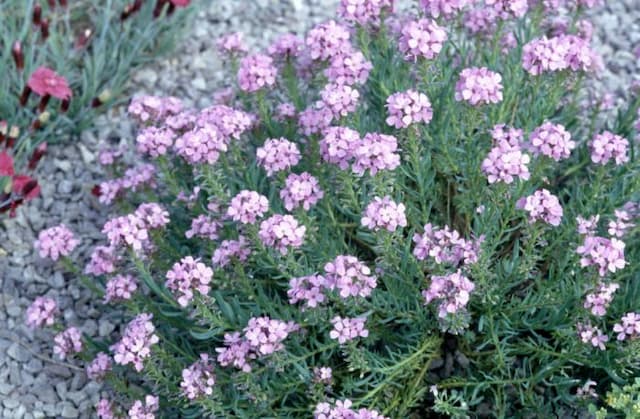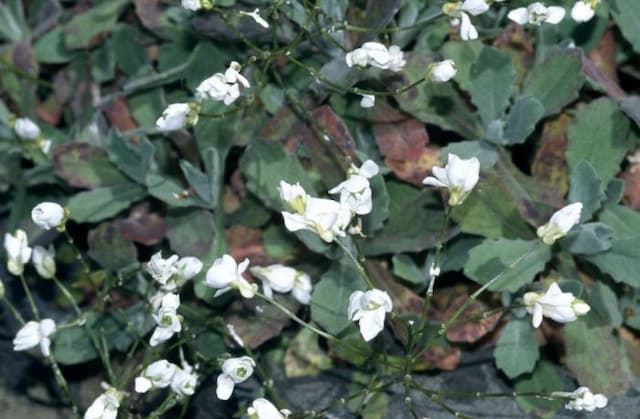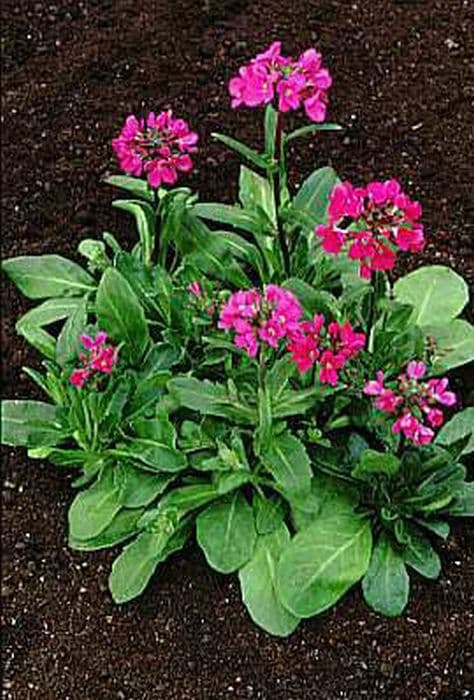Candytuft Iberis umbellata

ABOUT
The garden candytuft is a flowering plant known for its beautiful and vibrant display. This plant typically features dense clusters of small flowers that come in a range of colors including white, pink, purple, and lavender. These flowers are shaped like tiny, four-petaled crosses, which come together to form a flat-topped or slightly rounded cluster that blooms profusely throughout the flowering season. The foliage of the garden candytuft consists of narrow, oblong leaves that are a glossy, dark green color. These leaves are arranged alternately along the stems, providing a lush backdrop for the bright floral display. The overall impression is of a plant that is both compact and bushy, creating a cushion-like mound covered in a spray of colorful blooms. The delicate look of the flowers contrasts with the sturdy nature of the plant itself, which can tolerate a range of conditions. The blooms are often so abundant that they almost completely cover the foliage underneath, creating an eye-catching splash of color. Overall, the garden candytuft is appreciated for its cheerful appearance and its ability to bring a touch of spring and summer vibrancy to gardens and landscapes.
About this plant
 Names
NamesFamily
Brassicaceae.
Synonyms
Globe Candytuft, Candytuft, Umbrella Plant, Garden Candytuft.
Common names
Iberis coronaria, Iberis umbellata var. coronaria, Iberis umbellata var. umbellata, Iberis umbellata subsp. umbellata, Iberis intermedia, Iberis affinis, Crucifera iberis, Iberis gibralterica, Iberis diffusa, Thlaspi iberis.
 Toxicity
ToxicityTo humans
Iberis umbellata, more commonly known as candytuft, is not typically regarded as a toxic plant to humans. Consumption of candytuft is generally not associated with severe adverse effects. However, as with any plant, individuals with specific allergies or sensitivities may experience mild digestive distress or allergic reactions upon ingesting parts of the plant. It is always best to err on the side of caution and avoid consuming plants that are not widely recognized as food items.
To pets
Candytuft is also not commonly listed as a toxic plant to pets. It does not contain known toxins that would typically cause severe illness or symptoms of poisoning in pets such as cats and dogs. However, pets may still have individual sensitivities or allergic reactions that could cause mild gastrointestinal upset if they ingest parts of the plant. As with any non-food plant, keeping an eye on your pet and preventing them from ingesting candytuft is advisable, as it is not meant for consumption. If a pet does ingest candytuft and experiences unusual symptoms, contacting a veterinarian is recommended.
 Characteristics
CharacteristicsLife cycle
Annuals
Foliage type
Evergreen
Color of leaves
Green
Flower color
Varies
Height
6-18 inches (15-45 cm)
Spread
12-18 inches (30-45 cm)
Plant type
Herb
Hardiness zones
3-9
Native area
Mediterranean
Benefits
 General Benefits
General Benefits- Easy to grow: Iberis umbellata, also known as candytuft, is known for being a hardy plant that is easy to cultivate, making it suitable for gardeners of all skill levels.
- Drought-resistant: It can tolerate dry conditions once established, which makes it suitable for xeriscaping or gardens in arid climates.
- Attracts pollinators: Candytuft flowers attract various pollinators, including bees and butterflies, which are beneficial for the garden ecosystem and pollination of nearby plants.
- Low maintenance: The plant requires minimal care, does not need frequent fertilization, and is relatively pest-free, reducing the need for chemical treatments.
- Ornamental value: With its bright, showy flowers, candytuft adds visual appeal to gardens and landscapes.
- Ground cover: It can serve as an effective ground cover, reducing weed growth and soil erosion with its mat-forming habit.
- Extended blooming season: Candytuft has a lengthy flowering period from spring to early summer, offering long-lasting color in the garden.
- Versatility in landscaping: Iberis umbellata can be used in rock gardens, borders, and as a bedding plant, offering versatility in garden design.
 Medical Properties
Medical Properties- Anti-inflammatory: Iberis umbellata may possess properties that help in reducing inflammation.
- Cardiotonic: There is some historical use of Iberis umbellata as a heart tonic, potentially benefiting cardiac health.
- Diuretic: The plant has been traditionally used to promote the production of urine, helping in the reduction of fluid retention.
 Air-purifying Qualities
Air-purifying QualitiesThis plant is not specifically known for air purifying qualities.
 Other Uses
Other Uses- Iberis umbellata, commonly known as candytuft, can be used as a natural dye for fabrics, providing a range of colors depending on the mordant used.
- The plant's dense growth habit makes it suitable for use in erosion control on slopes and banks to stabilize the soil and prevent run-off.
- Candytuft's nectar-rich flowers are excellent for attracting beneficial insects like bees and butterflies to the garden for pollination services.
- The plant can be used as a living mulch to suppress weeds and retain soil moisture due to its mat-forming growth.
- Dried candytuft flowers can be incorporated into potpourri mixes for their pleasant fragrance and variety of colors.
- Candytuft can serve as a ground cover in graveyard plantings, providing a low-maintenance, decorative cover that is respectful and subdued.
- When planted in containers, candytuft adds a spill-over effect with its overflowing blooms, enhancing the visual appeal of patios and balconies.
- In landscape design, candytuft can be used to create a crisp, white edging along garden paths, driveways, or flower beds.
- The flowers can be used as a natural confetti for outdoor celebrations, decomposing quickly without harming the environment.
- Iberis umbellata can be planted as part of a green roof system to aid in temperature regulation of buildings while also adding aesthetics to the roof.
Interesting Facts
 Feng Shui
Feng ShuiCandytuft is not used in Feng Shui practice.
 Zodiac Sign Compitability
Zodiac Sign CompitabilityCandytuft is not used in astrology practice.
 Plant Symbolism
Plant Symbolism- Innocence - The small, delicate blooms of the candytuft (Iberis umbellata) often represent purity and innocence due to their bright white color, which is commonly associated with these traits.
- Indifference - In the language of flowers, or floriography, candytuft can sometimes symbolize indifference, possibly due to the ease with which the plant grows and its widespread abundance.
- Beauty - The candytuft's clusters of pretty flowers are often seen as a symbol of beauty, reflective of the plant's ornamental use in gardens and bouquets.
 Water
WaterTo properly water Candytuft (Iberis umbellata), ensure the soil is moist but well-drained, especially during its growing season in spring and summer. Water this plant deeply once a week, providing about one to two gallons per square yard of soil, adjusting for rainfall. If the weather is particularly hot and dry, you may need to water twice a week. During the winter months, reduce watering significantly as the plant requires less moisture and is at risk of root rot if overwatered. Always check the top inch of the soil before watering—if it's dry, it's time to water.
 Light
LightCandytuft thrives in full sun to partial shade, with preference towards a sunnier spot. Place it in a location where it can receive at least six hours of direct sunlight each day. While it can tolerate some light shade, too much shade can result in fewer flowers and a leggier plant. Avoid deeply shaded areas as this can severely impact the plant's health and flowering capabilities.
 Temperature
TemperatureCandytuft prefers temperatures ranging between 50°F and 75°F for ideal growth. While it can withstand temperatures slightly lower than 50°F, frost can damage the plant. On the higher end, Candytuft can tolerate temperatures up to 85°F but may require additional watering in such conditions. It's a hardy plant that can survive a winter low of around 20°F, but it's best to provide some protection like mulch if temperatures frequently drop below this point.
 Pruning
PruningCandytuft benefits from light pruning to encourage bushy growth and abundant blooms. Trim back the plant by about one-third immediately after flowering, usually in late spring or early summer. This prevents the plant from becoming woody and encourages a second flush of blooms. An annual pruning also helps to maintain a compact, attractive shape and rejuvenates the plant for the next season.
 Cleaning
CleaningAs needed
 Soil
SoilCandytuft (Iberis umbellata) thrives in well-draining soil with a mix of two parts loam, one part sand or perlite, and one part peat or compost. It prefers a pH between 6.0 and 7.5.
 Repotting
RepottingCandytuft typically doesn't need frequent repotting. It can be repotted every 2-3 years or when it outgrows its current container.
 Humidity & Misting
Humidity & MistingCandytuft is tolerant of a range of humidity levels and prefers average to dry conditions. It doesn't require high humidity to flourish.
 Suitable locations
Suitable locationsIndoor
Plant in well-draining soil, bright light, and water sparingly.
Outdoor
Plant in sunny area with well-draining soil and water moderately.
Hardiness zone
3-9 USDA
 Life cycle
Life cycleIberis umbellata, commonly known as Candytuft, begins its life cycle with seed germination, which requires a position in full sun and well-drained soil, usually occurring in early spring or after the last frost. The seedlings emerge and develop into small rosettes of narrow, dark green leaves, a stage where they are establishing roots and foliage. As temperatures warm, the plant enters the vegetative stage, producing more leaves and stems, preparing for the flowering stage. Flowering typically occurs in late spring to early summer, displaying clusters of flowers that range in color from white to pink and purple. After pollination, usually by insects, Candytuft produces fruit capsules containing seeds, completing its reproductive cycle. As an annual or short-lived perennial, depending on its growing conditions, Candytuft may die after setting seed, but it often self-sows, enabling new plants to grow the following season.
 Propogation
PropogationPropogation time
Spring to Summer
The most popular method of propagating Iberis umbellata, commonly known as Candytuft, is by seed. Seeds can be sown directly into the garden in spring, after the threat of frost has passed, or for an earlier bloom, they may be started indoors 6 to 8 weeks before the last expected frost. The seeds should be lightly covered with soil as they need darkness to germinate. The soil should be kept moderately moist until germination, which typically occurs within 14 to 21 days. Once the seedlings have developed their second set of true leaves, they can be thinned and eventually transplanted outside to their final positions, ensuring they are spaced about 8 to 10 inches (20 to 25 cm) apart to allow for proper growth and air circulation.






![Aubrieta [Axcent Burgundy]](/_next/image?url=https%3A%2F%2Fplants-admin.emdemapps.com%2Fimages%2Fplants%2F%2Fimages%2F604b5b7b548d8.png&w=640&q=75)


